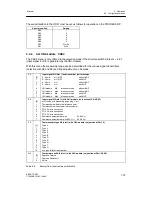
6 Commissioning
6.5 Automatic settingof controlparameters by the adaptationmethod
Manual
186
SIPART DR21
C73000-B7476-C143-08
6.5
Automatic setting of control parameters by the adaptation
method
see chapter 3.9 “Adaptation (S48)”, page 113
The adaptation method should always be preferred to manual settings because the control
results with the parameters gained from adaptation are better especially in slow controlled
systems and this saves optimization time.
D
Presetting
- S48 selecting the control behavior (structuring mode StrS)
No adaptation is possible when S48 = 0. In position 1 a control behavior without over-
shoot is offered. In position 2 changes in the command variables can be expected with a
maximum 5 % overshoot.
- tU: Monitoring time (parameterization mode AdAP)
tU is only necessary for the error messages and has no influence on the quality of
identification It can always be started with tU = oFF. Otherwise tU must be set at least
twice as great as the transient time T
95
of the controlled system. After successful
adaptation tU is automatically set to 2T
95
. At tU < 0.1 h (6 min), tU = oFF is displayed.
- Pv: Direction of the step command (parameterization mode AdAP)
The direction of the controlled variable change from the set operating point is selected
with this configuring switch: x
manual
±
Δ
x =
±
ks (y
manual
±
Δ
y). In controlled systems
with batches it is recommendable to perform one adaptation with rising x and one with
falling x. The averaged or dynamically more uncritical parameters can then be used for
the control.
- dy: Amplitude of the step command (parameterization mode AdAP)
The step command must be selected so great that the controlled variable changes by at
least 4 % and the controlled variable change must be 5 times the average noise level. The
greater the controlled variable change, the better the identification quality. Controlled variable
changes of approx. 10 % are recommended.
D
Notes on the adaptation results
- D-part
In S-controllers and K-controllers on 1st order controlled systems, the D part brings no
noticeable advantages due to the finite actuating time Ty or for reasons founded in the
control theory. The disadvantages in the form of wear on the positioning side dominate.
- Range limits
If one of the determined parameters reaches its range limits, the other parameter should
be adjusted slightly in the opposite direction of action.
If 8th order systems are identified, the determined kp must be reduced for safety
reasons. The determined Kp must be increased again if the control circuit is too slow
(uncritical).
Summary of Contents for SIPART DR21
Page 1: ...SIPART DR21 C73000 B7476 C143 08 1 SIPART DR21 6DR 210 Edition 08 2010 Manual ...
Page 2: ...SIPART DR21 C73000 B7476 C143 08 2 ...
Page 148: ...4 Installation 4 2 Electrical Connection Manual 148 SIPART DR21 C73000 B7476 C143 08 ...
Page 180: ...5 Operation 5 5 CPU self diagnostics Manual 180 SIPART DR21 C73000 B7476 C143 08 ...
Page 242: ...Manual 242 SIPART DR21 C73000 B7476 C143 07 ...
















































